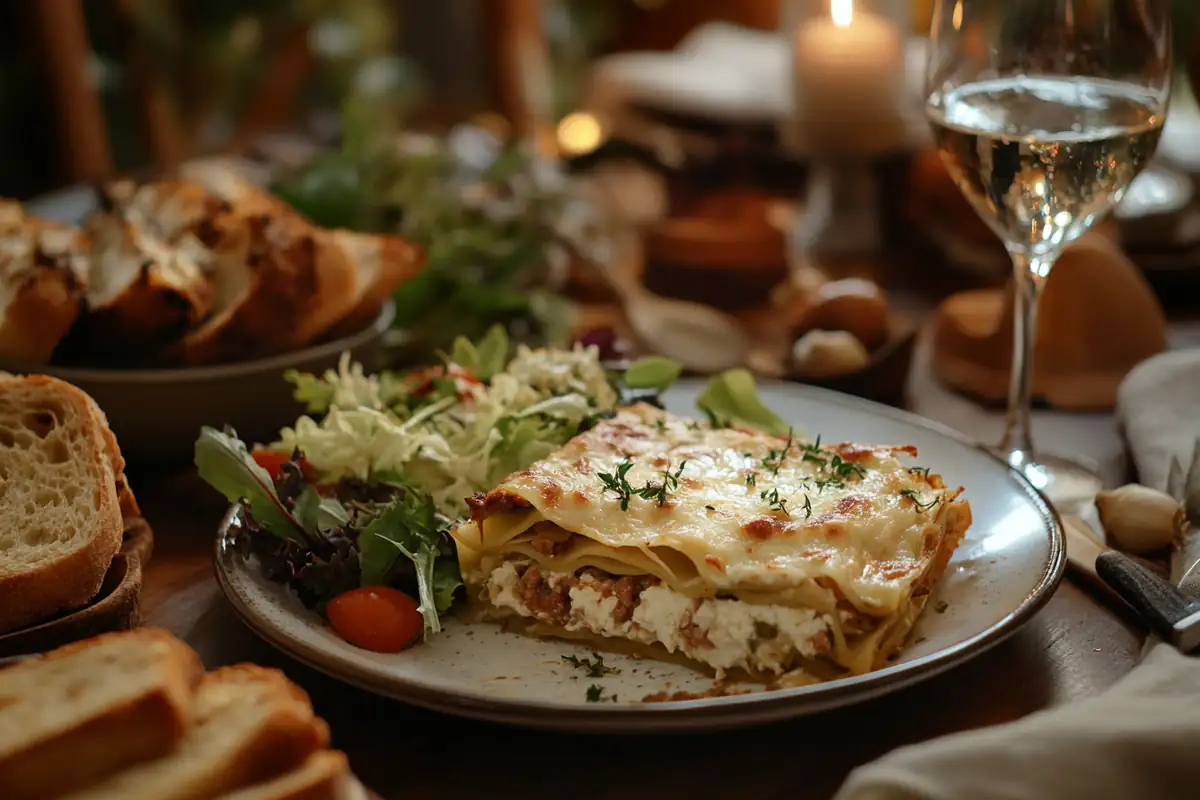Lasagna has long been the heart of Italian cuisine, combining layers of savory sauces, tender pasta, and bubbling cheese into a comforting dish enjoyed worldwide. Among the many recipes, Barilla Lasagna Recipe stands out for its ease, flavor, and authentic Italian feel. This guide walks you through everything from understanding the essential ingredients to perfecting the layering techniques that result in a masterpiece. Let’s dive into the delicious world of Barilla lasagna!
Introduction to Barilla Lasagna Recipe
The Rich History of Lasagna
Lasagna is more than just a dish; it’s a journey through centuries of Italian culture. Originating from the heart of Italy, lasagna dates back to ancient Rome, where layered pasta dishes were served as culinary luxuries. Over time, the dish evolved, integrating regional ingredients and becoming a symbol of Italian comfort food. Today, it continues to warm hearts across the globe.
Why Choose Barilla for Your Lasagna?
When it comes to preparing lasagna, Barilla is a trusted name in kitchens worldwide. Known for its high-quality pasta, Barilla offers lasagna sheets that are sturdy, versatile, and incredibly easy to work with. Unlike some brands, Barilla’s lasagna noodles are perfectly crafted to hold layers together without breaking or becoming mushy.
Furthermore, Barilla brings simplicity to the cooking process. Its lasagna sheets, especially the oven-ready variety, save time without compromising taste or texture. Whether you’re a seasoned cook or trying lasagna for the first time, Barilla ensures your dish turns out deliciously authentic.
Understanding the Components
Key Ingredients for Barilla Lasagna
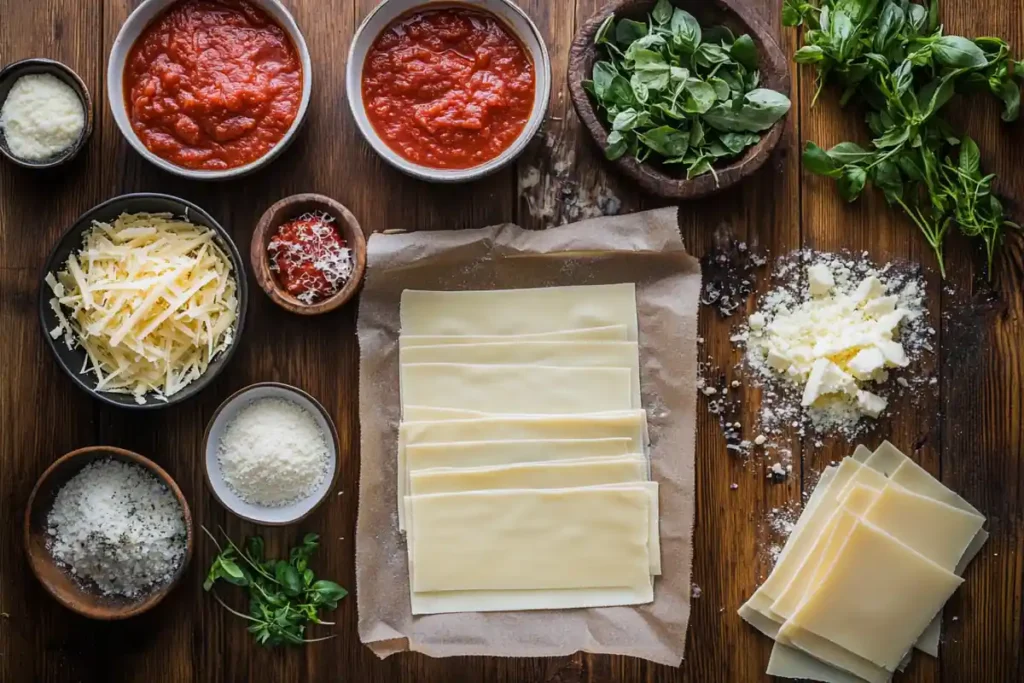
Creating the perfect Barilla Lasagna Recipe begins with choosing the right ingredients. Each component plays a critical role in building a dish that’s bursting with flavor and texture. Here’s what you need to know:
Selecting the Right Lasagna Noodles
Barilla lasagna noodles come in two varieties: oven-ready and traditional. The oven-ready sheets are a game-changer, saving time by eliminating the need to boil them beforehand. However, if you prefer the classic method, Barilla’s traditional noodles offer a smooth, firm texture that holds sauces and cheese beautifully.
Essential Sauces: Marinara and Béchamel
The sauces are the soul of a great lasagna. For marinara sauce, a rich blend of tomatoes, garlic, and herbs creates a robust flavor base. A creamy béchamel sauce adds a velvety smoothness, balancing the acidity of the marinara while enhancing the layers. Both are easy to make at home or can be store-bought for convenience.
Cheese Selection: Ricotta, Mozzarella, and Parmigiano-Reggiano
Cheese brings lasagna to life. Ricotta provides a creamy, mild layer, while mozzarella melts to perfection, creating that oozy, stretchy texture we all love. Parmigiano-Reggiano, with its nutty, sharp flavor, tops it off, lending an irresistible golden crust when baked.
Protein Options: Ground Beef, Sausage, and Alternatives
Classic lasagna often features a meat filling made from ground beef or Italian sausage, giving it a hearty, savory depth. For a vegetarian twist, roasted vegetables or plant-based proteins work beautifully. The key is to ensure the filling complements the marinara and cheese for a harmonious bite.
Preparing the Ingredients
Step-by-Step Preparation Guide
Before assembling your Barilla Lasagna Recipe, it’s essential to prepare each component with care. This ensures the flavors meld beautifully in the final dish.
Cooking the Meat Filling
Start by browning your choice of protein in a skillet over medium heat. Whether using ground beef, sausage, or a vegetarian alternative, ensure it’s fully cooked and crumbled into small pieces. Season with salt, pepper, and a pinch of Italian herbs for a flavorful base. Drain any excess fat to keep the dish light.
Crafting the Perfect Marinara Sauce
Homemade marinara sauce brings authenticity to your lasagna. Sauté garlic and onions in olive oil until fragrant, then add crushed tomatoes, tomato paste, and a dash of sugar to balance the acidity. Simmer with basil and oregano for about 20 minutes, stirring occasionally. This sauce can also be made ahead to save time.
Making a Smooth Béchamel Sauce
To prepare béchamel sauce, melt butter in a saucepan over low heat. Gradually whisk in flour to create a roux, then slowly add milk, stirring continuously to avoid lumps. Season with a pinch of nutmeg and salt. The result is a creamy, velvety sauce that layers beautifully between pasta sheets.
Preparing Barilla Lasagna Noodles
If you’re using traditional Barilla noodles, boil them in salted water until al dente. Drain and lay them flat on a towel to prevent sticking. For oven-ready noodles, there’s no need to pre-cook—just ensure there’s enough sauce to keep them tender during baking.
Assembling the Lasagna
Layering Techniques for Optimal Flavor
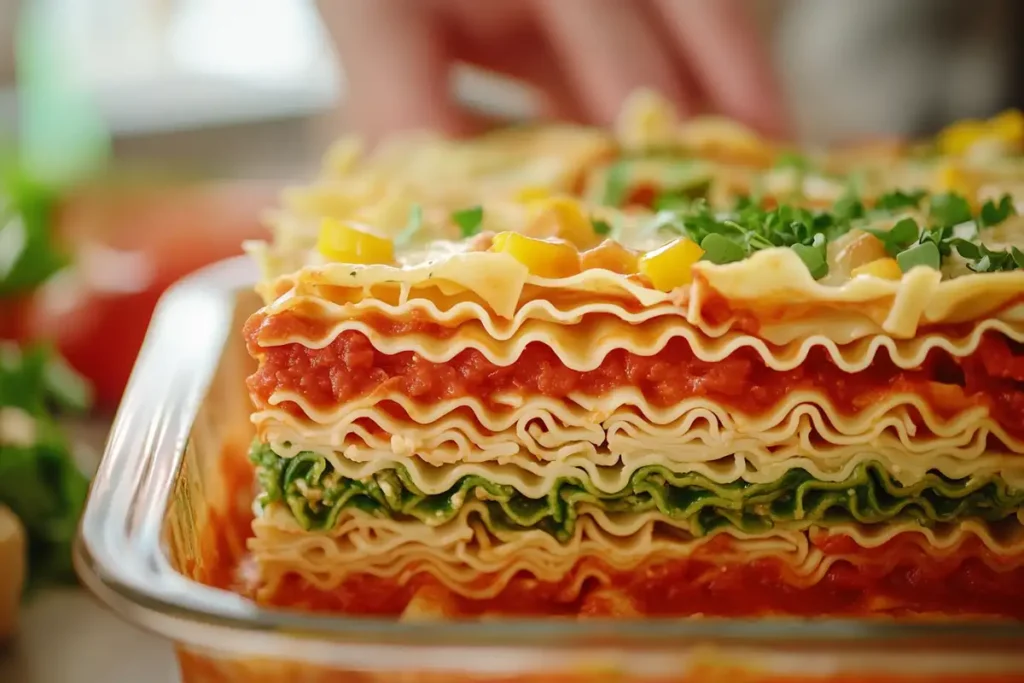
Assembling a Barilla Lasagna Recipe is an art form, where every layer contributes to a perfectly balanced and delicious dish. Here’s how to do it like a pro.
Starting with the Base Layer
Begin by spreading a thin layer of marinara sauce on the bottom of your baking dish. This prevents the lasagna noodles from sticking and ensures they absorb the flavorful sauce as they cook.
Alternating Layers: Noodles, Sauces, and Fillings
- First Layer: Lay Barilla lasagna noodles over the marinara base, slightly overlapping them to create a sturdy foundation.
- Second Layer: Spread an even layer of ricotta cheese, followed by a generous sprinkle of shredded mozzarella.
- Third Layer: Spoon the meat or vegetable filling evenly across the cheese, then top with another layer of marinara sauce.
Repeat these layers until your dish is almost full, ensuring each layer is smooth and evenly distributed. Aim for at least three complete sets of layers for a robust lasagna.
Topping Off: Final Layer and Cheese
For the top layer, place lasagna noodles, cover with marinara sauce, and generously sprinkle shredded mozzarella and grated Parmigiano-Reggiano. This layer forms the golden, bubbling crust that makes lasagna irresistible.
Tips for Assembly Success
- Avoid overloading any single layer, as this can cause uneven cooking.
- Use a spatula to gently press each layer down, ensuring a compact and cohesive dish.
- For added flavor, sprinkle a pinch of Italian seasoning or fresh basil between the layers.
Baking the Lasagna
Baking Instructions for Perfect Results
Once your Barilla Lasagna Recipe is beautifully assembled, the baking process transforms it into a bubbling masterpiece. Here’s how to achieve that golden, gooey perfection.
Oven Temperature and Timing
Preheat your oven to 375°F (190°C). Place the lasagna dish on the middle rack to ensure even heating. Bake for about 45 minutes to an hour. This allows the flavors to meld, the noodles to cook through, and the cheese to melt beautifully.
Covered vs. Uncovered Baking
- Covered Baking: For the first 30–40 minutes, cover the lasagna with aluminum foil. This traps moisture, preventing the noodles from drying out.
- Uncovered Baking: Remove the foil for the last 15–20 minutes to allow the cheese to brown and bubble, creating an irresistible crust.
Achieving a Golden-Brown Crust
If your cheese hasn’t browned enough after the baking time, broil the lasagna for an additional 2–3 minutes. Keep a close eye on it, as broiling can quickly turn golden perfection into burnt disaster!
Pro Tips for Baking Success
- Let the lasagna rest for 10–15 minutes after baking. This step helps the layers set, making it easier to slice and serve.
- Use a toothpick or knife to check if the noodles are tender before removing the lasagna from the oven.
Serving Suggestions
Serving Your Barilla Lasagna
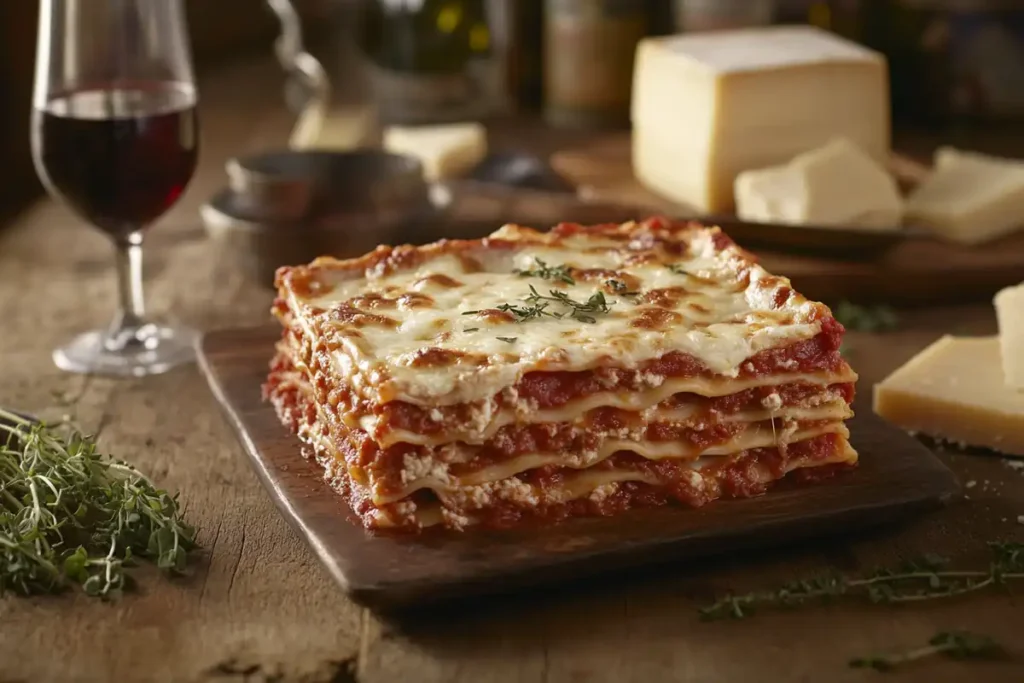
After baking and resting, it’s time to present your Barilla Lasagna Recipe in all its glory. Serving lasagna is as much about presentation as it is about pairing it with the right sides to complete the meal.
Ideal Side Dishes
Pairing lasagna with complementary sides elevates the dining experience. Here are some classic and creative options:
- Garlic Bread: Crispy on the outside and soft inside, it’s perfect for scooping up extra sauce.
- Fresh Green Salad: A light salad with mixed greens, cherry tomatoes, and balsamic vinaigrette balances the richness of the lasagna.
- Roasted Vegetables: Seasoned zucchini, bell peppers, or asparagus make a healthy and flavorful addition.
Presentation Tips
- Use a sharp knife to slice the lasagna into neat squares. Wipe the blade between cuts for clean edges.
- Serve each piece on a large plate to highlight its layered beauty. Garnish with a sprinkle of freshly grated Parmigiano-Reggiano or a sprig of basil.
Creative Serving Ideas
For individual servings, consider assembling lasagna in small ramekins or oven-safe dishes. This creates a personalized touch and ensures every diner gets their own bubbly, cheesy topping.
Variations and Dietary Considerations
Customizing Your Lasagna
The Barilla Lasagna Recipe is incredibly versatile, allowing you to tailor it to suit dietary preferences and creative inspirations. From vegetarian alternatives to gluten-free options, the possibilities are endless.
Vegetarian and Vegan Options
For a meat-free lasagna:
- Vegetarian: Replace the meat filling with a medley of roasted vegetables like eggplant, zucchini, mushrooms, and bell peppers. Add spinach or kale for extra nutrition.
- Vegan: Use plant-based ricotta and mozzarella. A cashew-based béchamel sauce can provide creaminess without dairy.
Gluten-Free Alternatives
Barilla offers gluten-free lasagna sheets, ensuring everyone can enjoy this classic dish. If unavailable, use thinly sliced zucchini or eggplant as a noodle substitute. These options are naturally gluten-free and add a unique flavor profile.
Incorporating Different Cuisines
Explore global variations to add excitement to your lasagna:
- Mexican Lasagna: Use tortillas instead of pasta sheets and layer with seasoned ground turkey, black beans, salsa, and cheese.
- Mediterranean Lasagna: Swap marinara for a tomato and feta sauce, layering with lamb or roasted vegetables and spiced béchamel.
Pro Tips for Variations
- Mix and match fillings and sauces for a one-of-a-kind flavor.
- Experiment with different cheese blends, such as gouda or fontina, for unique textures and tastes.
Storing and Reheating Leftovers
Proper Storage Techniques
The Barilla Lasagna Recipe tastes just as amazing the next day—if not better! Proper storage ensures the flavors remain intact and the texture stays perfect.
Refrigeration Guidelines
- Allow the lasagna to cool completely before storing. Placing hot lasagna in the fridge can create condensation, leading to soggy layers.
- Store leftovers in an airtight container or tightly cover the baking dish with plastic wrap or foil.
- Lasagna keeps well in the refrigerator for up to 3–4 days.
Freezing Lasagna for Future Meals
- Whole Lasagna: If you’ve prepared extra, wrap the entire unbaked or baked dish tightly in plastic wrap and aluminum foil. Label it with the date for easy tracking.
- Individual Portions: Cut lasagna into single servings and wrap each piece separately before placing them in a freezer-safe container.
Frozen lasagna remains fresh for up to three months.
Reheating Methods for Best Taste
- In the Oven: Preheat to 350°F (175°C). Place the lasagna in an oven-safe dish, cover with foil, and bake for 20–30 minutes until heated through.
- In the Microwave: For quicker results, heat a single portion in the microwave on medium power. Cover with a microwave-safe lid to retain moisture.
- On the Stovetop: Heat slices in a non-stick skillet with a splash of marinara sauce, covering with a lid to steam through.
Pro Tips for Reheating Success
- Add a drizzle of marinara or béchamel sauce to prevent dryness when reheating.
- Reheat lasagna directly from the freezer—just increase the cooking time accordingly.
Frequently Asked Questions
Should I bake lasagna covered or uncovered?
It depends on the desired result. Baking lasagna covered with foil for the first 30–40 minutes traps moisture, ensuring the noodles cook evenly and the layers meld beautifully. Uncovering it for the last 15–20 minutes allows the cheese to brown and form a bubbly crust, adding an irresistible texture.
Do you need to boil Barilla lasagna?
No, you don’t need to boil Barilla’s oven-ready lasagna sheets. They’re designed to soften perfectly during baking, provided there’s enough sauce to keep them moist. If you’re using traditional lasagna noodles, boiling them to an al dente texture is essential before layering.
How do you use Barilla lasagne sheets?
Barilla lasagna sheets are straightforward to use. Place them directly into the baking dish without pre-cooking if they’re oven-ready. For traditional noodles, boil them first, drain, and pat dry. Always ensure each sheet is fully covered with sauce during assembly to avoid dryness.
What are the correct layers for lasagna?
The traditional layering sequence is as follows:
- Sauce as the base layer.
- Lasagna noodles.
- Cheese or ricotta layer.
- Meat or vegetable filling.
- Repeat the layers, ending with noodles, sauce, and a generous sprinkle of cheese.
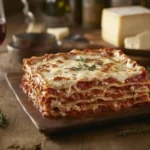
Classic Barilla Lasagna
- Total Time: 1 hour
- Yield: 8 servings 1x
Description
This classic lasagna recipe, featuring Barilla lasagna sheets, layers of rich meat sauce, creamy ricotta, and gooey mozzarella, is a comforting and crowd-pleasing dish. It’s simple to make and perfect for feeding a hungry family or serving at gatherings.
Ingredients
For the Meat Sauce:
- 1 tablespoon olive oil
- 1 medium onion, finely chopped
- 2 cloves garlic, minced
- 1 pound ground beef or turkey
- 1 jar (24 oz) Barilla Traditional Pasta Sauce
- 1 teaspoon dried basil
- 1 teaspoon dried oregano
- Salt and pepper to taste
For the Cheese Mixture:
- 2 cups ricotta cheese
- 1 large egg
- 1/2 cup grated Parmesan cheese
- 1 teaspoon dried parsley
- Salt and pepper to taste
For Assembly:
- 1 box Barilla Oven-Ready Lasagna Sheets
- 2 cups shredded mozzarella cheese
- 1/2 cup grated Parmesan cheese (for topping)
Instructions
- Prepare the Meat Sauce:
- Heat olive oil in a large skillet over medium heat. Add onion and garlic; sauté until softened and fragrant.
- Add ground beef or turkey, breaking it apart with a spoon, and cook until browned.
- Stir in Barilla Traditional Pasta Sauce, basil, oregano, salt, and pepper. Simmer for 10 minutes, stirring occasionally. Remove from heat.
- Prepare the Cheese Mixture:
- In a medium bowl, combine ricotta cheese, egg, Parmesan cheese, parsley, salt, and pepper. Mix until smooth and set aside.
- Assemble the Lasagna:
- Preheat oven to 375°F (190°C).
- In a 9×13-inch baking dish, spread a thin layer of meat sauce to coat the bottom.
- Place a layer of Barilla Oven-Ready Lasagna Sheets over the sauce.
- Spread 1/3 of the ricotta mixture over the sheets, then 1/3 of the meat sauce, and 1/3 of the mozzarella cheese.
- Repeat the layers (lasagna sheets, ricotta, meat sauce, mozzarella) two more times.
- Top with the remaining Parmesan cheese.
- Bake the Lasagna:
- Cover the dish with aluminum foil and bake in the preheated oven for 25 minutes.
- Remove the foil and bake for an additional 15 minutes, or until the cheese on top is golden and bubbly.
- Let the lasagna rest for 10 minutes before slicing and serving.
Notes
- For a vegetarian option, substitute the ground meat with sautéed spinach, mushrooms, or lentils.
- Barilla Oven-Ready Lasagna Sheets do not require pre-boiling, making the process faster and more convenient.
- Store leftovers in an airtight container in the refrigerator for up to 3 days or freeze for up to 3 months.
- Prep Time: 20 minutes
- Cook Time: 40 minutes
- Category: Main Dish
- Method: Baking
- Cuisine: Italian
Nutrition
- Serving Size: 1 slice
- Calories: 430
- Sugar: 5g
- Sodium: 710mg
- Fat: 21g
- Saturated Fat: 10g
- Unsaturated Fat: 9g
- Trans Fat: 0g
- Carbohydrates: 31g
- Fiber: 3g
- Protein: 28g
- Cholesterol: 80mg
Keywords: Lasagna, Barilla Recipe, Comfort Food, Pasta Bake

